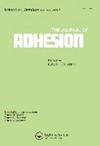Comparative analysis of primers and alternative polypropylene pre-treatment techniques
IF 2.3
4区 材料科学
Q2 ENGINEERING, CHEMICAL
引用次数: 0
Abstract
ABSTRACTThe test polypropylene substrates obtained from the original plastic car parts for Škoda Superb were subjected to 10 pre-treatment techniques: solvent cleaning (isopropanol, xylene), mechanical abrasion, immersion in a chromic acid mixture, flame activation, atmospheric and low-pressure plasma treatment, corona discharges and the application of two different primers (also called adhesion promoters). One of the primers, based on chlorinated polypropylene, was commercially available, while the other was prepared in our laboratory using polypropylene grafted with maleic anhydride. The test substrates were characterized using contact angle measurement for designation of surface free energy, Atomic Force Microscope (AFM) for roughness analysis, Scanning Electron Microscopy (SEM) for surface topography, and Energy Dispersive X-ray Spectrometry (EDX) for surface oxygen and contamination analysis. The suitability of the surface preparation methods in the industry was evaluated through peel strength tests (adhesive bonding process) and cross-cut tests (painting process). Not all tested methods were effective in increasing adhesion, especially in the adhesive bonding process, and even fewer in the painting process. However, some of them were suitable for both applications. The use of primers was found to be crucial.KEYWORDS: Plasticspolypropyleneadhesionsurface pre-treatmentadhesion promotersprimers AcknowledgmentsThe authors thank: Łukasiewicz Research Network - Institute for Engineering of Polymer Materials and Dyes for conducting plasma and corona discharge trials; Maflow Plastics Poland for receiving polypropylene samples and adhesive tapes.Disclosure statementNo potential conflict of interest was reported by the author(s).Additional informationFundingThis research did not receive any specific grant from funding agencies in the public, commercial, or not-for-profit sectors.底漆与聚丙烯预处理技术的比较分析
摘要:从Škoda Superb原塑料汽车零件中获得的聚丙烯基材进行了10项预处理技术:溶剂清洗(异丙醇、二甲苯)、机械磨损、铬酸混合物浸泡、火焰活化、常压和低压等离子体处理、电晕放电和两种不同的底漆(也称为附着力促进剂)的应用。其中一种引物是基于氯化聚丙烯的市售引物,而另一种引物是在我们实验室用聚丙烯接枝马来酸酐制备的。使用接触角测量表征表面自由能,原子力显微镜(AFM)进行粗糙度分析,扫描电子显微镜(SEM)进行表面形貌分析,能量色散x射线光谱(EDX)进行表面氧和污染分析。通过剥离强度试验(胶粘接工艺)和横切试验(涂漆工艺)对工业表面制备方法的适用性进行了评价。并不是所有的测试方法都能有效地增加附着力,特别是在胶粘接过程中,在涂装过程中就更少了。然而,其中一些适用于这两种应用程序。引物的使用被认为是至关重要的。关键词:塑料聚丙烯粘接表面预处理粘接促进剂喷剂感谢:Łukasiewicz研究网络-高分子材料与染料工程研究所进行等离子体和电晕放电试验;Maflow塑料波兰接收聚丙烯样品和胶带。披露声明作者未报告潜在的利益冲突。本研究没有从公共、商业或非营利部门的资助机构获得任何特定的资助。
本文章由计算机程序翻译,如有差异,请以英文原文为准。
求助全文
约1分钟内获得全文
求助全文
来源期刊

Journal of Adhesion
工程技术-材料科学:综合
CiteScore
5.30
自引率
9.10%
发文量
55
审稿时长
1 months
期刊介绍:
The Journal of Adhesion is dedicated to perpetuating understanding of the phenomenon of adhesion and its practical applications. The art of adhesion is maturing into a science that requires a broad, coordinated interdisciplinary effort to help illuminate its complex nature and numerous manifestations.
 求助内容:
求助内容: 应助结果提醒方式:
应助结果提醒方式:


